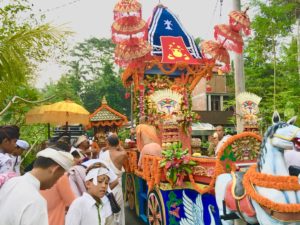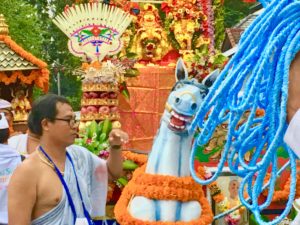The post Demystifying Reincarnation Talks appeared first on The Spiritual Scientist.
Demystifying Reincarnation Talks
ISKCON London 2017 Mentorship Retreat at Plas Glansevin in Wales…
→ Dandavats

ISKCON London 2017 Mentorship Retreat at Plas Glansevin in Wales (2 min video)
This year we had the great fortune to have HH Kadamba Kanana Swami as our guest speaker.
Maharaja took us through the theme of - “The Essence of Bhakti”, the nine processes of devotional service.
The retreat lasted 5 days, giving the mentees the unique opportunity to dive deeper into their Krishna conscious life. The retreat provided to all the opportunity for vaisnava sanga, kirtan, seva, and delicious prasadam… all focused to help uplift and rejuvenate body, mind and soul.
Watch it here: https://goo.gl/5RJtx6
ISKCON Dhaka, Radha Krishna Performance in A Manipuri dance
→ Dandavats
 ISKCON Dhaka, Radha Krishna Performance in A Manipuri dance (8 min video)
Srila Prabhupada: Every one of us is searching after some mellow, some ...
ISKCON Dhaka, Radha Krishna Performance in A Manipuri dance (8 min video)
Srila Prabhupada: Every one of us is searching after some mellow, some ... Lecture on Pastimes of Lord Jagannath
Bhakti Charu Swami
H.H. Bhakti Charu Swami Maharaja recently visited Dubai. On 26th June 2017 Bhakti Charu Swami gave a nectarian class on the pastimes of Lord Jagannath for Ujjain devotees. For hearing the Lecture please visit:-
The post Lecture on Pastimes of Lord Jagannath appeared first on Bhakti Charu Swami.
Local Rathayatras
→ Ramai Swami
All the temples in Bali celebrate Rathayatra on the scheduled day of the year. Some take out Their Lordships, Jagannatha, Baladeva and Subhadra Devi on a big cart around the area and others simply take Them on a palanquin around the temple.
Their Lordships enjoy a nice promenade and, of course, the devotees enjoy every festival, especially Rathayatra. Everyone will come together for the big Rathayatra festival in downtown Denpasar.
Demystifying Reincarnation 11 – Consciousness – Intuitions that point beyond the brain
→ The Spiritual Scientist
Answer Podcast
The post Demystifying Reincarnation 11 – Consciousness – Intuitions that point beyond the brain appeared first on The Spiritual Scientist.
Daily Darshan: June 28th, 2017
→ Mayapur.com
The post Daily Darshan: June 28th, 2017 appeared first on Mayapur.com.
Monday, June 26th, 2017
→ The Walking Monk
One must always be connected to the Spiritual Master
→ Servant of the Servant
Paramahamster – New Business Cards
→ ISKCON News
When Airavata existed earlier, how did he appear during the churning of the milk ocean?
→ The Spiritual Scientist
Podcast
The post When Airavata existed earlier, how did he appear during the churning of the milk ocean? appeared first on The Spiritual Scientist.
Why is remembrance of Krishna so important in bhakti ?
→ The Spiritual Scientist
Podcast
The post Why is remembrance of Krishna so important in bhakti ? appeared first on The Spiritual Scientist.
How can we better appreciate the relevance of spiritual classes as well as academic studies?
→ The Spiritual Scientist
Podcast
The post How can we better appreciate the relevance of spiritual classes as well as academic studies? appeared first on The Spiritual Scientist.
During possession, what is the relation between the subtle bodies of the possessing ghost and the possessed person?
→ The Spiritual Scientist
Podcast
The post During possession, what is the relation between the subtle bodies of the possessing ghost and the possessed person? appeared first on The Spiritual Scientist.
When the possessed soul and the possessor soul are equal, how can one soul dominate another ?
→ The Spiritual Scientist
Podcast
The post When the possessed soul and the possessor soul are equal, how can one soul dominate another ? appeared first on The Spiritual Scientist.
Do the laws of material nature work on ghosts ?
→ The Spiritual Scientist
Podcast
The post Do the laws of material nature work on ghosts ? appeared first on The Spiritual Scientist.
Is our life duration determined by past karma?
→ The Spiritual Scientist
Podcast
The post Is our life duration determined by past karma? appeared first on The Spiritual Scientist.
When the soul is different from the body, why does injury to the brain cause the soul to leave the body, but not injury to the foot
→ The Spiritual Scientist
Some people can see ghosts, some can’t – why?
→ The Spiritual Scientist
Podcast
The post Some people can see ghosts, some can’t – why? appeared first on The Spiritual Scientist.
Slovenia this week
→ The Vaishnava Voice
Some pictures from this week:
The Slovenian landscape is 60% forest
Burger bars are not my usual haunt but this one was special: Radha Govinda in downtown Ljubliana
Looking every inch the Buddhist chef in this designer ensemble is Mrigendra das, TV cook and organiser of the wedding feast
An upturned salad cup: even more tasty than it looks.
A fleet of srikhand and halava boats
The happy couple cut the wedding cake: Prema Gopi and Bharata
The Bob Dylan of Slovenia
Meanwhile, back in England, devotees sang in the sunshine at Glasto.
Escape the illusion
→ KKSBlog
(Kadamba Kanana Swami, 16 July 2012, Modra, Slovakia, Lecture)
 In so many ways, maya (the illusory energy) is infiltrating our lives. Maya is everywhere. They say maya is a witch. For the male, maya takes a female form and for the female, maya takes a male form. In this way, maya has only one purpose which is to bind the living beings. Different chains are being used; chains of greed, chains of anger but the strongest chain of all is known as mayy āyuṅktām anugraham (Srimad Bhagavatam 3.14.11), the chain of sex! That is maya’s most powerful weapon because that makes us think that the material world is a place to enjoy.
In so many ways, maya (the illusory energy) is infiltrating our lives. Maya is everywhere. They say maya is a witch. For the male, maya takes a female form and for the female, maya takes a male form. In this way, maya has only one purpose which is to bind the living beings. Different chains are being used; chains of greed, chains of anger but the strongest chain of all is known as mayy āyuṅktām anugraham (Srimad Bhagavatam 3.14.11), the chain of sex! That is maya’s most powerful weapon because that makes us think that the material world is a place to enjoy.
Lord Caitanya comes to the rescue
→ SivaramaSwami.com
Krishna The Lover Of The Gopis
→ ISKCON News
Transit Point
→ SivaramaSwami.com
Krsna-lila’s video about volunteers of various religious backgrounds, including Bhakta Vatsala prabhu and Hungarian FFL devotees helping refugees, got into the top 10 of the American Religious Newswriters’ Association’s ‘Faith Counts’ video contest.
Please help the film to get the ‘Audience Award’ by sharing and voting. Follow the link below to watch the film and click “VOTE”.
What is the role of the Kirtan leader, spiritually?
→ Dandavats
 By Bada Haridas
By Bada Haridas Krishna is present in His Name. He is there when we are chanting. Sometimes when we chant, by His mercy, we really feel His presence. We know He is there and the kirtan becomes very wonderful. I experience this in different ways, never quite the same. The Lord in His deity form, Srila Prabhupada, or other spiritual personalities, appear in the mind. Sometimes spiritual feelings arise. RadheShyamAlachua2 Although Krishna is always there, sometimes we don’t feel His presence. He keeps Himself hidden, and I feel like a stone and the chanting seems empty. Krishna does this so that we will examine our heart and, with greater humility and sincerity, call out to Him. It’s not automatic or mechanical bliss, there is a reciprocation going on. Somehow, we need to chant and hear. But that is our time to be with Krishna and we need to be aware of what is happening in our relationship with the Lord. If this seems like too much work sometimes, you can always go back to the basic instruction of chanting and hearing, and bringing the mind back to being present with each mantra. This is the basic instruction Srila Prabhupada gives and we don’t have to over think this. Chant with the tongue and hear with the ears. But it is natural that, as the mind settles down and you become absorbed in chanting, devotional feelings come. Continue reading "What is the role of the Kirtan leader, spiritually?
→ Dandavats"
Kirtan in the World Religions
→ Dandavats
 By Satyaraja Das
By Satyaraja Das Robert Gass, author of Chanting: Discovering Spirit in Sound, believes that ritual chanting is among the most universal of human impulses, as well as one of the first: “We have no recordings of the earliest humans,” he writes, “but when we encounter indigenous tribes who’ve had little contact with modern civilization, they all have sacred chants that their oral history traces back to their earliest origins. And if you look into creation myths from different cultures, in almost every case the world is said to come into being through sound, through chant. It’s in Hinduism, Christianity, Judaism, and Native American religions. That’s evidence, in a way. The other evidence you can look at is young children: Almost all young children make up repetitive songs — they lose themselves in the rapture of singing.” Continue reading "Kirtan in the World Religions
→ Dandavats"
Greed…
→ Dandavats

Greed…
Radhanath Swami: Wherever we see the greed for wealth, gold, power, prestige, name or fame – consequently we see a rise in hate, envy, fighting and war.
Greed is a source of misery because it never gets satisfied. Its demand increases more and more, despite of our efforts to pacify it. It is compared to feeding a blazing fire, no matter how much amount of fuel you put in, the fuel gets consumed in seconds. It always ends in dissatisfaction.
Read More...
Preaching program in Krasnoyarsk, Russia (Album with…
→ Dandavats
 Preaching program in Krasnoyarsk, Russia (Album with photos)
Bhakti Caitanya Swami: Photos from the temple and our hall program in Krasnoyarsk in...
Preaching program in Krasnoyarsk, Russia (Album with photos)
Bhakti Caitanya Swami: Photos from the temple and our hall program in Krasnoyarsk in... Glastonbury, UK, 2017. Harinama, Kirtana, and Prasadam…
→ Dandavats
 Glastonbury, UK, 2017. Harinama, Kirtana, and Prasadam distribution (Album with photos)
Srila Prabhupada: It is the duty of the mahatmas to chan...
Glastonbury, UK, 2017. Harinama, Kirtana, and Prasadam distribution (Album with photos)
Srila Prabhupada: It is the duty of the mahatmas to chan... Hare Krishna! The movie: Film Review by Rachael…
→ Dandavats

Hare Krishna! The movie: Film Review by Rachael Stark.
Coinciding with the 50th year anniversary of the birth of the ISKCON movement, Director John Griesser and co-directors Jean Griesser and Lauren Ross, have brought the film, “Hare Krishna! The Mantra, The Movement and the Swami who started it all,” to theaters world-wide celebrating the extraordinary life of Srila Prabhupada. The film, which debuted in New York City’s East Village, on June 16th, is a rare, thoughtful, and vivid glimpse of the worldwide Krishna movement and the complex state-of-the-world that Prabhupada encountered.
To behold the miraculous journey of Srila Prabhupada, founder and spiritual emissary of ISKCON (International Society for Krishna Consciousness), is to witness
a dream fulfilled; an epic nothing short of the divine.
This dynamic new film directed by John Griesser and co-directed by Jean Griesser and Lauren Ross titled, “Hare Krishna! The Mantra, The Movement and the Swami who started it all,” attempts to chronicle his extraordinary life and succeeds—not only as a first-rate biopic but also as a profound examination of America and the world during a turbulent 1960’s and 1970’s when Vietnam, racial injustice, and the Cold War had descended.
Through vivid documentary footage and thoughtful, probing interviews with former devotees and scholars, a portrait of Prabhupada emerges. At once intimate and complex, the charismatic Prabhupada comes alive, particularly his immense capacity for devotion. For many in the Krishna movement, the biographical details of Prabhupada’s life are known. Yet they are no less dramatic for the retelling and the filmmakers do an excellent job of overlaying imagery, narration, and incorporating ethereal music and chanting to tell their story. Truth is grander than fiction, the backdrop all too real. The most imaginative fairy tale or Horatio Alger story couldn’t be more vivid than the events of Prabhupada’s life.
In 1965, at the age of 70, the penniless Swami from Kolcotta abandoned his beloved India and traveled by cargo ship to New York City’s Lower East Side—a far cry from America’s gold-paved streets–where he undertook the singular task of beginning a world-wide devotional movement. Black-and-white photographs—Prabhupada in his monk’s clothing, stubble visible on his face- against the backdrop of the jagged streets of New York City –offer the audience a visceral glimpse into the world in which Prabhupada emerged, a reminder of the leap of faith required for this former businessman to start a spiritual revolution alone in a strange land.
With only sacred texts and a 16-word mantra for companions, Prabhupada takes up residence in a storefront on 26th street and Second Avenue and begins his Homeric task. At the behest of his guru, Prabhupada arrived to bring Krishna consciousness to the West and superb first-hand footage shows just how skillfully he translated his mission into the quotidian of daily life; prayer, sharing food, reading from his beloved Bhagavad Gita to those who sought refuge. Soon, a rag-tag handful of devotees understand his message of “bhakti” –devotion and love to all– and are mesmerized.
As momentum builds for the Krishna movement and ISKCON’s devotees grow in number, the filmmakers also portray the “other” America outside of Prabhupada’s sanctuary. Finding themselves an international presence (there is wonderful and surprising footage of parades in London that fill Trafalgar Square, Washington Square Park in New York City alive and electric with Krishna devotional dancing), there are also those that have little, if no regard, for Prabhupada or his teachings—a secular America weary of cults and “thought programing” who believe that Prabhupada mission is ephemeral; a temporary haven for the disenfranchised.
There are clips from “Anti-Cult Movement experts” who warn of the dangers of “mind control” and the film depicts the “People versus Murphy” when criminal charges were brought against two devotees, a case that went to the New York City Supreme Court only to be dismissed. As one of Prabhupada’s closest associates tells us, “The more Prabhupada got attacked, the more energized he became.” Ever assured of the power of his teachings, Prabhupada had used only The Bhagavad Gita for his defense.
Ultimately, however, what makes the film such a vibrant portrayal of the history of the Krishna movement, is its refusal to give in to stereotypes or the grandiose–from painting Prapubadha and his devotees in too broad strokes. Perhaps the most telling vignette about Prabhupada, comes from rare footage of a trip he undertook to the Soviet Russia. In 1971 almost no Americans, certainly not Swamis, were granted visas. Yet, he applied and visited the country. Upon his arrival at Moscow, his Bhagavad Gita was confiscated by customs and after being detained, was finally released.
Instead of feeling bitter, the viewer watches him wander through Moscow, amazed, reflective, ever attentive to the beauty of the churches and architecture. Probing beneath the surface, as he so often did, Prabhupada sees the presence of Soviet guards and lack of crowds at religious sites, only noting with compassion, “the ordinary citizens of Russia are spiritual but because of their leaders they have no access to God anymore.”
As his death becomes imminent, the filmmakers bring the audience into his inner circle seated at Prabhupada’s bedside in the holy city of Vrindavan. Feeble, barely audible, his body a shell, he is nonetheless still hard at work. A devotee holds a tape recorder to his dying lips to allow Prabhupada to record his last words, “we are not this body. We are eternal life. It is an immense measure of freedom.”
“In the 12 years that he was alive,” the credits at the film’s end inform us, “he circled the globe 14 times, established 108 temples on 6 continents [and] saw 60-millions of his books distributed in 25 languages.” Whether you are a person of faith, a devotee, a skeptic, atheist, agnostic, or student, the film, “Hare Krishna! The Mantra, The Movement, and the Swami who started it all,” will amaze you. It is an insightful, enduring portrait about one of the most important figures of the twentieth century whose message of Krishna consciousness continues to reverberate in today’s fragile world.
*Rachael Stark is an Adjunct Professor of Technology, Culture, and Society at NYU Tandon School of Engineering and an Adjunct Professor of Creative Writing at St. John’s University. She has her MFA in writing and has published numerous articles in Namarupa, The Brooklyn Daily Eagle, and is a featured blogger for The Huffington Post. She teaches yoga and is working on a novel.”
Rachael Stark interviews Lauren Ross: Co-Director and Producer:
“Hare Krishna! The Mantra, The Movement and the Swami who started it all.”
Lauren Ross is the Co-Director, Producer, and Editor of “Hare Krishna! The Mantra, The Movement and the Swami who started it all.” The film, which debuted in New York City and Los Angeles in June, is opening at selected theatres world-wide. While traveling in Los Angeles, Ms. Ross spoke about the film’s premise, its meaning in these fractured times, and her belief in Prabhupada’s message. What follows are brief excerpts from our conversation:
Rachael Stark: I’d like to take a moment to assess the film in our culture at large. Recently, Wonder Woman has been released in the mainstream media and the modern version of the heroine, played by Israeli actress, Gal Gadot, has been lauded as a contemporary epic—a much needed heroine for our times. Transitioning from the fiction of Hollywood to the documentary, “Hare Krishna! The Mantra, The Movement and the Swami who started it all,” can you speak a little bit about Prabhupada’s actual journey and his mission? In other words, why is this movie so critical and why is it vital that we hear Prabhupada’s story now?
Lauren Ross: It’s interesting that Prabhupada came to America in the 60’s and 70’s, at a time of great revolution and change when people were looking at the world and the state of it and questioning their own identities thinking, ‘I am so dissatisfied. Is this it? Who am I, really? What is my purpose in life? Is this all there really is–getting married, having kids, working a job—and if it is, why do I feel so empty.?’
And so, particularly in this climate, I think that Prabhupada’s message was revolutionary. Here was this man saying, ‘we are so much more than these material bodies. We need to connect with this idea and we also very much need to connect with one another. These are the things that truly bring us together as human beings. Our souls. That’s our commonality.’
That was, and still is, a timeless message. Just looking now at America now and the world in general, there’s so much discrimination, so much hate speech. In reference to your point about Wonder Woman, people are really looking for heroes. We all want people who lead by example and that’s exactly what Prabhupada did. It wasn’t that he just ‘went home’ and was a different person. People then, and also nowadays, want deeper answers to their questions and more profound solutions. Prabhupada’s story and in particular, him as a character, is more relevant today than ever.
But unlike a fictional superhero, Prabhupada was very humble. He never put emphasis on himself. He made his mission universal and he was steadfast in it. And that mission was, ‘Practice.’ ‘Bhakti.’ ‘Yoga.’ He told the world that there was wisdom that you can find in other traditions. He always emphasized our humanness, that we, as souls, are all connected to one another. Therefore, how can you hate someone who shares a soul with you?
RS: Can you speak a little bit about what initially drew you to this project and what, in particular, what the most poignant moment of the filming?
LR: Initially, I had been on a journey myself. I had been living in Sydney, Australia and I had similar questions such as, ‘why do I feel like something is always missing? I have all these things but something just doesn’t feel right.’ So, I went traveling for about year and I found myself in India and in Nepal feeling happier than I had been in a long time. When I came back to Australia, a producer friend of mine put me in contact with John and Jean Griesser [the directors of the film] and I fell in love with Prabhupada’s story. That’s how I initially got drawn to the project and I’ve been working on it for 3-4 years.
In fact, the whole journey and the making of this film has felt very transformative. It feels like Prabhupada is very much alive. His voice has been such a guiding voice. But I have to say that the most significant memory was having the chance to film the
re-enactments of his life when Prabhupada was a boy and when he was also a young man, visiting Kolkata where he grew up, filming the scenes where he watched his father perform religious rituals and all the while remembering that at the age of twenty-two, when his teacher told him to go to the West, it wouldn’t be for another fifty years that he could fulfill this journey. Even though he was married and had children, he patiently waited for his moment to begin. That was particularly inspiring.
RS: Finally, if you could address the “average” viewer directly, someone who has never heard of Prabhupada, who knows nothing about the Krishna movement or ISKCON, a non-devotee or “non-believer”—what would you want a spectator to take away from the film?
LR: I guess first and foremost, I would want the “average person” to take away an appreciation of Prabhupada. Here is a very unique story of a man who had two heart attacks on a freight ship from Kolkata to New York City and another heart attack later in the country. Yet he created a whole history–an entire movement all on his own, the Hare Krishna movement that is now global.
Then of course, I would also hope the film inspires dialogue for people to see it but especially in their daily life. For example, we often hear of bad experiences about different religions or customs we’re not familiar with—but after viewing this film, I hope that it will encourage everyday people to explore different ways of finding spirituality and happiness and how they can share these experiences with others to form community.
In other words, Prabhupada’s message was that spiritual life can be accessible to anyone. Everything that you do in your life can bring you spiritual perspective. Religious devotees aren’t just a stereotypical vision that society has of bald-headed men dancing in bed sheets. I would hope the film opens and provides prospective on the whole Hare Krishna movement and that this film shows the fun, complex story of an extraordinary man and moment in history with all of its true ups and downs.
Ratha Yatra Rijeka 2017 (Album with photos)
→ Dandavats

Ratha Yatra Rijeka 2017 (Album with photos)
Srila Prabhupada: The mango fruit is different from the name of the mango. One cannot taste the mango fruit simply by chanting, “Mango, mango, mango.” But the devotee who knows that there is no difference between the name and form of the Lord chants Hare Krishna and realizes that he is always in Krishna’s company. (Srimad-Bhagavatam, 10.2.36 Purport).
Find them here: https://goo.gl/NiqeHw
Supporting the Hari-nama Party.
Giriraj Swami: Sri Rama Raya and…
→ Dandavats

Supporting the Hari-nama Party.
Giriraj Swami: Sri Rama Raya and his Hari-Nama-sankirtana party are faithfully executing Srila Prabhupada’s mission as explained in his letter to authorities in America in 1969: “Our basic mission is to propagate the sankirtana movement (chanting of the holy names of God) all around the world as was recommended by the Lord, Sri Chaitanya Mahaprabhu. People in this age are reluctant very much to understand about God consciousness on account of their unfortunate condition of life. They are working hard day and night simply for sense gratification. But this transcendental vibration of sankirtana will knock at the door of their hearts for spiritual awakening. Therefore, they should be given the chance for this opportunity.
“It is not recommended that a Krishna conscious devotee go into seclusion for chanting by himself and thereby gaining salvation for himself alone. Our duty and religious obligation is to go out into the streets where the people in general, can hear the chanting and see the dancing. We have already seen practically how by this process many, many boys and girls of America and Europe have been saved from the immoral practices of this age and have now dedicated their lives for the service of Krishna.”
To taste and share the nectar of God’s holy names, the devotees of the New York City hari-nama party brave all kinds of weather and surroundings and responses from people; they live in austere conditions and eat the most simple prasada.
These devotees are fulfilling the words of Sarvabhauma Bhattacarya, Lord Chaitanya’s intimate associate, in Susloka-satakam, 62:
yad avadhi hari nama pradur asit prithivyam
tad avadhi khalu loka vaisnavah sarvatas te
tilaka vimala mala nama yuktah pavitrah
hari hari kali madhye evam evam babahuva
“From the moment that the holy names of Krishna became manifest on the earth, Vaishnavas began appearing everywhere. Wearing tilaka and neck beads and equipped with the maha-mantra, they are present in the very midst of the darkest of ages, purifying the atmosphere by chanting ‘Hari! Hari!’ ”
These Hari-Nama devotees are worthy of our full support. If possible, we should join them for chanting, and we can also help by cooking and providing other services, and by contributing financially. To donate, simply go to the Yuga Dharma Ashram website https://www.nycharinam.org/donate and select a donation option (monthly or one-time).
“Lord Sri Caitanya Mahaprabhu is the father and inaugurator of the sankirtana movement. One who worships Him by sacrificing his life, money, intelligence, and words for the sankirtana movement is recognized by the Lord and endowed with His blessings.” (Sri Caitanya-caritamrta, Adi 3.78 purport)
Hare Krishna!
Yours in service,
Giriraj Swami
Heart of a Vaishnava revealed
→ Dandavats
 By Giriraj Das
By Giriraj Das Haridas spoke to the Lord with folded hands, “O Lord, I have known only misfortune yet You give me so much hope. Just allow me to partake of the remnant of foodstuffs of Your devotees totally surrendered to Your lotus feet. Let this activity be my permanent and most prominent service life after life. My sinful birth and existence is miserable, without remembering You, but now please make my life successful by granting me the remnant of Your servitors. Continue reading "Heart of a Vaishnava revealed
→ Dandavats"
Happy Soul (30 min video) Biographical film about Atmarama…
→ Dandavats
 Happy Soul (30 min video)
Biographical film about Atmarama Prabhu (ACBSP).
His popular instrument for making bhajan is guitar which is making hi...
Happy Soul (30 min video)
Biographical film about Atmarama Prabhu (ACBSP).
His popular instrument for making bhajan is guitar which is making hi... Demystifying Reincarnation 10 – Near Death Experiences – Conscious when unconscious?
→ The Spiritual Scientist
Answer Podcast
The post Demystifying Reincarnation 10 – Near Death Experiences – Conscious when unconscious? appeared first on The Spiritual Scientist.
Beautiful and Merciful Vrindadevi
Giriraj Swami
 Recently our beautiful deity of Vrindadevi arrived at our ashram in Carpinteria. As Srila Visvanatha Cakravarti Thakura prays in his Vrindadevi-astaka (3, 6, 8):
Recently our beautiful deity of Vrindadevi arrived at our ashram in Carpinteria. As Srila Visvanatha Cakravarti Thakura prays in his Vrindadevi-astaka (3, 6, 8):
samasta-vaikuntha-siromanau sri-
krsnasya vrndavana-dhanya-dhamni
dattadhikare vrsabhanu-putrya
vrnde namas te caranaravindam
“Vrishabhanu’s daughter Radha made you guardian of Krishna’s opulent and auspicious abode of Vrindavan, the crest jewel of all Vaikuntha planets. O Vrinda, I bow to your lotus feet.”
rasabhilaso vasatis ca vrnda-
vane tvad-isanghri-saroja-seva
labhya ca pumsam krpaya tavaiva
vrnde namas te caranaravindam
“By your mercy people attain residence in Vrindavan, the desire to serve your masters’ lotus feet, and the desire to assist in the rasa dance. O Vrinda, I bow to your lotus feet.”
bhaktya vihina aparadha-laksaih
ksiptas ca kamadi-taranga-madhye
kpamayi tvam saranam prapanna
vrnde namas te caranaravindam
“O merciful one, I am devoid of devotion, and millions of offenses have thrown me into the turbulent waves of lust, anger, greed, and other faults. O Vrinda, I take shelter of your lotus feet.”
Hare Krishna.
Yours in service,
Giriraj Swami
Daily Darshan: June 27th, 2017
→ Mayapur.com
The post Daily Darshan: June 27th, 2017 appeared first on Mayapur.com.
Sunday June 25, 2017
→ The Walking Monk
The Longest Day (BBC Pause for Thought 22 June 2017)
→ Krishna Dharma
 Officially, the summer solstice is the longest day – almost 17 hours of broad daylight. However, in my experience the length of the day depends largely upon what I happen to be doing. How could I ever forget, for example, those interminable history lessons at school. The clock on the wall all but froze as the teacher apprised us of the fascinating exploits of Oliver Cromwell and his gallant roundheads.
Officially, the summer solstice is the longest day – almost 17 hours of broad daylight. However, in my experience the length of the day depends largely upon what I happen to be doing. How could I ever forget, for example, those interminable history lessons at school. The clock on the wall all but froze as the teacher apprised us of the fascinating exploits of Oliver Cromwell and his gallant roundheads.
Thankfully I am no longer subjected to such torture, but now I find that on the sacred days when I fast, time does drag on a bit. I have never been a huge fan of bodily privation, I have to admit, but for the sake of my soul it must be done, so once a month or so, I man up and stay out of the kitchen for a long hard day.
It certainly does seem to me that time stretches during testing periods. A friend once had a serious incident while driving. His car overturned at speed and he told me that it seemed to take several minutes, when in fact it all happened in a few seconds. On the other hand, as we all know, time flies when you’re having fun.
Einstein spoke about the relativity of time in relation to the speed of light and it is also discussed by Krishna in the ancient Sanskrit teaching Bhagavad Gita – but in a different way. There it is said that time depends upon the observer’s consciousness and that time is a material phenomenon. The more a person is spiritually connected to God , the less time will affect them. In other words, although time swallows up everything in this material world, it cannot affect the true spiritual self, which is beyond matter and eternal.
The Gita says that realising this truth about the self means experiencing unending spiritual joy, forever free from the ravages of time. It’s something I strive for, but I have to be honest, I’m still some way from that spiritual joy on the days I have to fast.
















